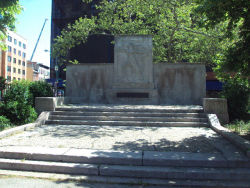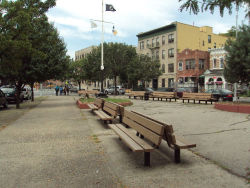Zion Triangle
Zion Triangle
In 1896, the City of Brooklyn acquired this triangular property, bounded by Legion Street, Pitkin, and East New York Avenue at the junction of Eastern Parkway. The new park, or “gore” (small, triangular parcel) as it was called then, was donated by landowner Peter L. Vandeveer, and known in its early years as Vandeveer Park. The 1896 Brooklyn Parks Annual Report noted a small shelter at the site and noted that the park “will be exceedingly useful as a resting place for bicycle riders who use the Glenmore Avenue route to the good roads of Queens County.” In 1911, the park was renamed Zion Park by the Board of Aldermen. Zion is derived from an Old Testament reference to the City of David.
In 1923, Alexander S. Drescher, chairman of the Citizens’ Memorial Committee and the Soldiers’ and Sailors’ Memorial Committees of the American Legion and Veterans of Foreign Wars (Local Boards 82 and 88), petitioned Brooklyn Borough Parks Commissioner John N. Harman to erect a World War I monument here, and sought $5,000 worth of site improvements to accommodate the memorial. Though delays in financing postponed construction, the project went forward in 1925. The Zion Park War Memorial, also known as the Brownsville War Memorial, was created by the well-known sculptor Charles Cary Rumsey (1879–1922) and dedicated in 1925.
The neighborhood of Brownsville was named for Charles S. Brown, who built a small tract of homes here in the mid-19th century. After train service was extended to the area, the neighborhood became populated by Manhattan garment workers. In 1911, when Zion Park was named, the neighborhood was largely Jewish, and many notable Americans grew up in the area, including composer Aaron Copland (1900–1990) and performer Danny Kaye (1913-1987). The W.P.A. Guide to New York City, written in the 1930s, reported that there were over 70 orthodox synagogues in Brownsville.
The park was renamed Loew Square by the Board of Alderman in 1930. The Loew’s Pitkin Theatre, part of the movie theater chain started by Marcus Loew (1870–1927), formerly stood nearby on the corner of East New York and Pitkin Avenues. After World War II the area’s residents began moving to the suburbs. Today the neighborhood is largely African American; boxers Mike Tyson and Riddick Bowe both hail from Brownsville. In 1987, Commissioner Stern restored the name Zion, and in 1997 it became Zion Triangle, reflecting its size, shape, and relative lack of vegetation.
Check out your park's Vital Signs
Clean & Safe
Green & Resilient
Empowered & Engaged Users
Share your feedback or learn more about how this park is part of a
Vital Park System


